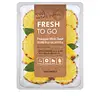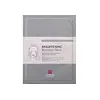What's inside
What's inside
 Key Ingredients
Key Ingredients

 Benefits
Benefits

 Concerns
Concerns

 Ingredients Side-by-side
Ingredients Side-by-side

Water
Skin ConditioningGlycerin
HumectantButylene Glycol
HumectantAlcohol
AntimicrobialCyclopentasiloxane
Emollient1,2-Hexanediol
Skin ConditioningBetaine
HumectantPEG-60 Hydrogenated Castor Oil
EmulsifyingArginine
MaskingCyclohexasiloxane
EmollientCarbomer
Emulsion StabilisingPEG-10 Dimethicone Crosspolymer
StabilisingAnanas Sativus Fruit Extract
Skin ConditioningXanthan Gum
EmulsifyingHydroxyethyl Acrylate/Sodium Acryloyldimethyl Taurate Copolymer
Emulsion StabilisingHydroxyethylcellulose
Emulsion StabilisingCamellia Sinensis Leaf Extract
AntimicrobialDisodium EDTA
Dipotassium Glycyrrhizate
HumectantZingiber Officinale Root Extract
MaskingGlycyrrhiza Glabra Root Extract
BleachingSchisandra Chinensis Fruit Extract
Skin ConditioningPanthenol
Skin ConditioningCoptis Chinensis Root Extract
AntioxidantRoyal Jelly Extract
Skin ConditioningIris Pallida Root Extract
MaskingSorbitan Isostearate
EmulsifyingPolysorbate 60
EmulsifyingCaprylyl Glycol
EmollientPerilla Ocymoides Leaf Extract
TonicChlorphenesin
AntimicrobialParfum
MaskingWater, Glycerin, Butylene Glycol, Alcohol, Cyclopentasiloxane, 1,2-Hexanediol, Betaine, PEG-60 Hydrogenated Castor Oil, Arginine, Cyclohexasiloxane, Carbomer, PEG-10 Dimethicone Crosspolymer, Ananas Sativus Fruit Extract, Xanthan Gum, Hydroxyethyl Acrylate/Sodium Acryloyldimethyl Taurate Copolymer, Hydroxyethylcellulose, Camellia Sinensis Leaf Extract, Disodium EDTA, Dipotassium Glycyrrhizate, Zingiber Officinale Root Extract, Glycyrrhiza Glabra Root Extract, Schisandra Chinensis Fruit Extract, Panthenol, Coptis Chinensis Root Extract, Royal Jelly Extract, Iris Pallida Root Extract, Sorbitan Isostearate, Polysorbate 60, Caprylyl Glycol, Perilla Ocymoides Leaf Extract, Chlorphenesin, Parfum
Water
Skin ConditioningMethylpropanediol
SolventButylene Glycol
HumectantGlycerin
HumectantChamomilla Recutita Flower Extract
MaskingDipropylene Glycol
HumectantNiacinamide
Smoothing1,2-Hexanediol
Skin ConditioningPortulaca Oleracea Extract
Skin ConditioningAcer Saccharum Extract
Skin ConditioningLactobacillus
Skin ConditioningHydroxyethyl Acrylate/Sodium Acryloyldimethyl Taurate Copolymer
Emulsion StabilisingBetaine
HumectantXanthan Gum
EmulsifyingCaprylyl Glycol
EmollientEthylhexylglycerin
Skin ConditioningParfum
MaskingPolysorbate 60
EmulsifyingSorbitan Isostearate
EmulsifyingArtemisia Capillaris Flower Extract
Skin ConditioningEcklonia Cava Extract
Skin ConditioningHouttuynia Cordata Extract
Skin ConditioningLedum Palustre Extract
MaskingSaururus Chinensis Extract
Skin ConditioningAchillea Millefolium Extract
CleansingArnica Montana Flower Extract
MaskingArtemisia Absinthium Extract
Skin ConditioningGentiana Lutea Root Extract
Skin ConditioningAlchemilla Vulgaris Extract
AstringentAlcohol
AntimicrobialMalva Sylvestris Extract
AstringentMelissa Officinalis Leaf Extract
Skin ConditioningMentha Piperita Leaf Extract
Skin ConditioningPrimula Veris Extract
Skin ConditioningVeronica Officinalis Extract
Skin ConditioningAcetyl Tetrapeptide-40
Skin ConditioningWater, Methylpropanediol, Butylene Glycol, Glycerin, Chamomilla Recutita Flower Extract, Dipropylene Glycol, Niacinamide, 1,2-Hexanediol, Portulaca Oleracea Extract, Acer Saccharum Extract, Lactobacillus, Hydroxyethyl Acrylate/Sodium Acryloyldimethyl Taurate Copolymer, Betaine, Xanthan Gum, Caprylyl Glycol, Ethylhexylglycerin, Parfum, Polysorbate 60, Sorbitan Isostearate, Artemisia Capillaris Flower Extract, Ecklonia Cava Extract, Houttuynia Cordata Extract, Ledum Palustre Extract, Saururus Chinensis Extract, Achillea Millefolium Extract, Arnica Montana Flower Extract, Artemisia Absinthium Extract, Gentiana Lutea Root Extract, Alchemilla Vulgaris Extract, Alcohol, Malva Sylvestris Extract, Melissa Officinalis Leaf Extract, Mentha Piperita Leaf Extract, Primula Veris Extract, Veronica Officinalis Extract, Acetyl Tetrapeptide-40
 Reviews
Reviews

Ingredients Explained
These ingredients are found in both products.
Ingredients higher up in an ingredient list are typically present in a larger amount.
1,2-Hexanediol is a synthetic liquid and another multi-functional powerhouse.
It is a:
- Humectant, drawing moisture into the skin
- Emollient, helping to soften skin
- Solvent, dispersing and stabilizing formulas
- Preservative booster, enhancing the antimicrobial activity of other preservatives
Alcohol comes in many different forms. Different types of alcohol will have different effects on skin. This ingredient is usually an astringent alcohol.
These alcohols are drying on the skin. They may strip away your skin's natural oils and even damage your skin barrier. Astringent alcohols may also irritate skin.
Other types of astringent alcohols include:
According to the National Rosacea Society based in the US, you should be mindful of products with these alcohols in the top half of ingredients.
Any type of sanitizing product will have high amounts of alcohol to help kill bacteria and viruses.
Fatty alcohols come from plant oils such as coconut oil. These can help hydrate the skin and are non-irritating. Some fatty alcohols include cetyl and stearyl alcohol.
Learn more about AlcoholBetaine is a common humectant (a substance that promotes retention of moisture). It's known to be gentle on the skin and can help balance hydration.
This ingredient is best for improving hydration and soothing irritated skin. Studies also show it helps even out skin tone.
Fun fact: Betaine is naturally created in the skin and body. The kind found within cosmetic products can be either plant-derived or synthetic.
Another name for betaine is trimethylglycine.
Learn more about BetaineButylene Glycol (or BG) is used within cosmetic products for a few different reasons:
Overall, Butylene Glycol is a safe and well-rounded ingredient that works well with other ingredients.
Though this ingredient works well with most skin types, some people with sensitive skin may experience a reaction such as allergic rashes, closed comedones, or itchiness.
Learn more about Butylene GlycolCaprylyl Glycol is a humectant and emollient, meaning it attracts and preserves moisture.
It is a common ingredient in many products, especially those designed to hydrate skin. The primary benefits are retaining moisture, skin softening, and promoting a healthy skin barrier.
Though Caprylyl Glycol is an alcohol derived from fatty acids, it is not the kind that can dry out skin.
This ingredient is also used as a preservative to extend the life of products. It has slight antimicrobial properties.
Learn more about Caprylyl GlycolGlycerin is already naturally found in your skin. It helps moisturize and protect your skin.
A study from 2016 found glycerin to be more effective as a humectant than AHAs and hyaluronic acid.
As a humectant, it helps the skin stay hydrated by pulling moisture to your skin. The low molecular weight of glycerin allows it to pull moisture into the deeper layers of your skin.
Hydrated skin improves your skin barrier; Your skin barrier helps protect against irritants and bacteria.
Glycerin has also been found to have antimicrobial and antiviral properties. Due to these properties, glycerin is often used in wound and burn treatments.
In cosmetics, glycerin is usually derived from plants such as soybean or palm. However, it can also be sourced from animals, such as tallow or animal fat.
This ingredient is organic, colorless, odorless, and non-toxic.
Glycerin is the name for this ingredient in American English. British English uses Glycerol/Glycerine.
Learn more about GlycerinThis is a synthetic polymer. It helps improve the texture of products by adding thickness and gel-like feel.
It is also an emulsifer, meaning it prevents ingredients such as oil and water from separating. It also helps evenly disperse other ingredients.
Parfum is a catch-all term for an ingredient or more that is used to give a scent to products.
Also called "fragrance", this ingredient can be a blend of hundreds of chemicals or plant oils. This means every product with "fragrance" or "parfum" in the ingredients list is a different mixture.
For instance, Habanolide is a proprietary trade name for a specific aroma chemical. When used as a fragrance ingredient in cosmetics, most aroma chemicals fall under the broad labeling category of “FRAGRANCE” or “PARFUM” according to EU and US regulations.
The term 'parfum' or 'fragrance' is not regulated in many countries. In many cases, it is up to the brand to define this term.
For instance, many brands choose to label themselves as "fragrance-free" because they are not using synthetic fragrances. However, their products may still contain ingredients such as essential oils that are considered a fragrance by INCI standards.
One example is Calendula flower extract. Calendula is an essential oil that still imparts a scent or 'fragrance'.
Depending on the blend, the ingredients in the mixture can cause allergies and sensitivities on the skin. Some ingredients that are known EU allergens include linalool and citronellol.
Parfum can also be used to mask or cover an unpleasant scent.
The bottom line is: not all fragrances/parfum/ingredients are created equally. If you are worried about fragrances, we recommend taking a closer look at an ingredient. And of course, we always recommend speaking with a professional.
Learn more about ParfumPolysorbate 60 is used to help stabilize products. It is a surfactant and emulsifier. These properties help keep ingredients together in a product. Surfactants help reduce surface tension between ingredients with different states, such as liquids and solids. Emulsifiers help prevent oils and waters from separating.
Polysorbate 60 is sorbitol-based and created from the ethoxylation of sorbitan. Ethoxylation is a chemical reaction used to add ethylene oxide. Sorbitan is a the dehydrated version of sorbitol, a sugar found in fruits.
In this case, the 60 comes from reacting 60 units of ethylene oxide with sorbitan.
Polysorbates are commonly used in medicine and foods.
Learn more about Polysorbate 60Sorbitan Isostearate is an emulsifer and cleaning agent. It is created from isostearic acid and sorbitol.
As an emulsifier, Sorbitan Isostearate prevents oils and water from separating.
Due to its isostearic acid base, it may not be safe for Malassezia or fungal acne.
Learn more about Sorbitan IsostearateWater. It's the most common cosmetic ingredient of all. You'll usually see it at the top of ingredient lists, meaning that it makes up the largest part of the product.
So why is it so popular? Water most often acts as a solvent - this means that it helps dissolve other ingredients into the formulation.
You'll also recognize water as that liquid we all need to stay alive. If you see this, drink a glass of water. Stay hydrated!
Learn more about WaterXanthan gum is used as a stabilizer and thickener within cosmetic products. It helps give products a sticky, thick feeling - preventing them from being too runny.
On the technical side of things, xanthan gum is a polysaccharide - a combination consisting of multiple sugar molecules bonded together.
Xanthan gum is a pretty common and great ingredient. It is a natural, non-toxic, non-irritating ingredient that is also commonly used in food products.
Learn more about Xanthan Gum